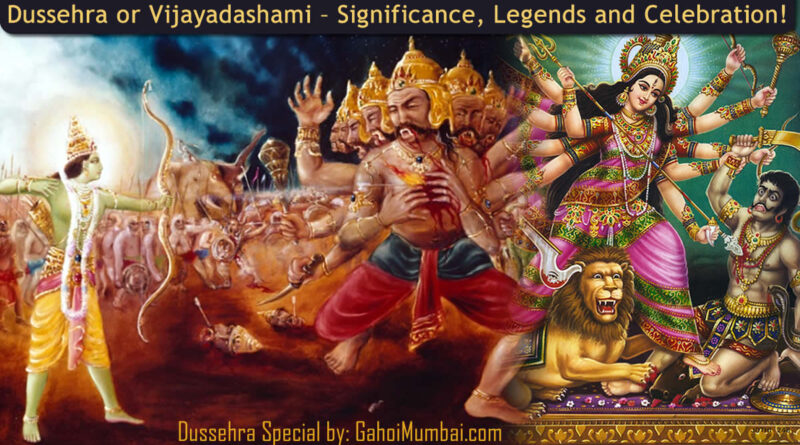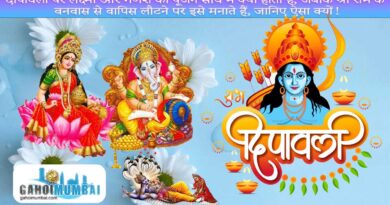Dussehra or Vijayadashami – Significance, Legends and Celebration!
Dussehra or Dasara or Dashain is an important Hindu festival which is also known as Vijayadashami. Dussehra or word Dasahara (Dasa means 10 headed Ravana and Hara means defeat) is denoted the victory of Shri Ram – a God Vishnu Avatar over ten headed demon Ravana. Furthermore, Vijayadashami is denoted the victory on the tenth day in the Hindu calendar month Ashwin. Its celebration is mark of culmination of Navratri every year. It is generally happened on the tenth day in the Hindu calendar month of Ashwin, the seventh month of the Hindu Luni-Solar Calendar, which generally falls in the Gregorian months of September and October every year.
Vijayadashami is celebrated in different reasons in different regions. In the souther, eastern, north-eastern and some other states, this festival marks the culmination of Durga Puja as celebration of goddess Durga’s triumph over the buffalo demon Mahishasura. While In northern, central and western states, the Dussehra denotes the celebration of shri Ram’s victory over ten headed Ravana who kidnapped maa Sita and takes her to his kingdom Lanka.
Vijayadashami or Dussehra celebrations include processions to a river or ocean front that involve carrying clay statues of Maa Durga and its various avatars with music and chants and after reaching shore of river or ocean, all clay statues are immersed in the water for dissolution and farewell. For the remembering victory of good over evil, on Dussehra, organizer are burnt the towering effigies of Ravana with fireworks to celebrate the triumph of shri Ram (Good) over demon king ten headed Ravana (evil). The festival also marks the starting preparations for Diwali – a festival of lights, which is observed twenty days after Vijayadashami.
Dussehra or Vijayadashami Celebration Time and Date: Dussehra or Vijayadashami is celebrated on the 10th day of the month of Ashwin (September–October) or the seventh month of the Hindu calendar, with the appearance of the full moon, an event called the “bright fortnight” (shukla paksha). Dussehra coincides with the culmination of the nine-day Navratri festival and with the tenth day.
Legends of Dussehra or Vijayadashami Celebration:
As per Ramayana’s legend, demon king Ravana abducts Maa Sita and takes her to his kingdom in Lanka (Sri Lanka). Shri Ram requests Ravana to release her, but ten-headed egoist demon king rejects his plea. This situation escalates and leads to war between Ram’s Vanar Sena and Ravana’s Asur Sena. After doing life-threatening penance for ten thousand years, Ravana obtains a boon from the creator-god Brahma; he could from now not be killed by gods, demons, or spirits. Lord Vishnu incarnates as the human Rama to defeat and kill him, thus avoiding the boon given by Lord Brahma. A deadly and fierce battle takes place between Rama and Ravana in which Rama kills Ravana and ends his evil rule. In the last, Dharma was established on the Earth because of Rama’s victory over Ravana. The festival observes the victory of Good over Evil.
Diversity in Celebration of Dussehra or Vijayadashami:
In northern and western regions of India, this festival is celebrated in honour of Shri Rama. The drama-dance-music plays based on the Ramayan and Ramcharitmanas (Ramlila) are acted at outdoor fairs across the land and in provisionally built staging grounds featuring effigies of the demons Ravan, Kumbhakarna and Meghanada. The effigies are burnt on bonfires in the evening of Vijayadashami or Dussehra. In numerous places, the “Rama Lila” – a story of Rama, Sita and Lakshmana, is enacted over the 9 days before it, but in some places, such as Varanasi, the whole story is freely acted out by performance-artists before the public every evening for a month. These story tale arts and plays come to a close on the night of Dussehra, when the victory of Rama is celebrated by burning the effigies of evil Ravan and his sons.
It is celebrated in historically important Hindu cities of Ayodhya, Varanasi, Vrindavan, Almora, Satna and Madhubani with enthusiasm and fervour.
In eastern India, especially in West Bengal, Vijayadashami is celebrated as Bijoya Dashomi, immediately after the day of Dashomi (the tenth day of Navaratri). It is observed by processions in which clay statues of Durga, Lakshmi, Saraswati, Ganesha and Kartikeya are taken to a river or ocean for a solemn goodbye to Durga. Many mark their faces with vermilion (sindoor) or wear red clothing. It is an emotional day for some disciples, particularly the Bengalis, and even for numerous atheists as the congregation sings goodbye songs. When the procession reaches the water, the clay statues of Durga and her four children are immersed; the clay dissolves and they are believed to return to Mount Kailasha with Shiva, and to the heavens in general. People distribute sweets and gifts, and visit friends and family members.
In Gujarat, both the goddess Durga and Lord Rama are revered for their victory over evil. Fasting and prayers at temples are observed. A regional dance called Dandiya Raas, that arranges colourfully decorated sticks, and Garba, that is, dancing in traditional dress, is a part of the festivities through the night.
In Goa, this festival is locally known as Dasro in Konkani, denotes Goddess Durga’s victory over the demon Mahishasura, concludes the festivities




